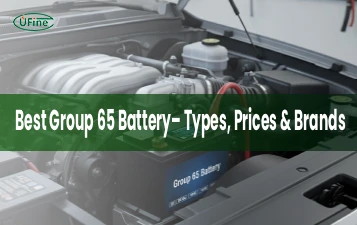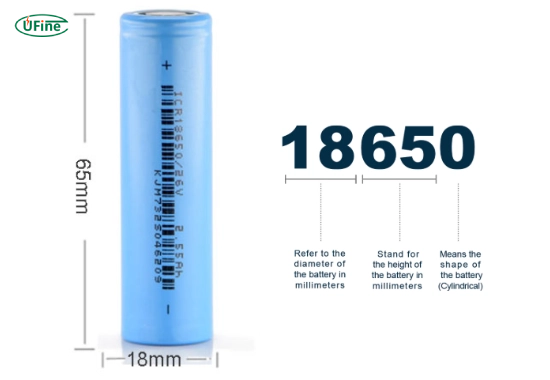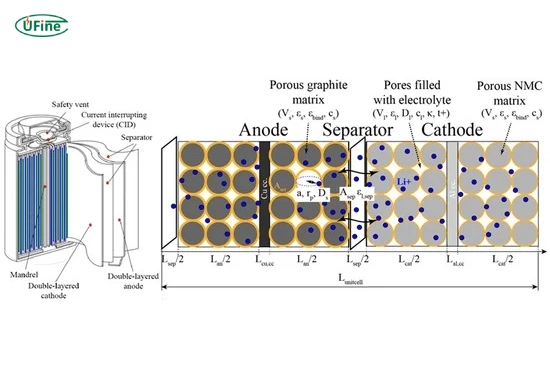
- Part 1. What is an ICR18650 battery?
- Part 2. What does ICR mean in lithium batteries?
- Part 3. What makes 18650 batteries special?
- Part 4. What is the chemistry behind ICR18650 batteries?
- Part 5. What are the common uses of ICR18650 batteries?
- Part 6. What are the limitations of ICR18650 batteries?
- Part 7. How does ICR compare to IMR and INR batteries?
- Part 8. What safety features should be used with ICR18650 batteries?
- Part 9. How long do ICR18650 batteries last?
- Part 10. Can ICR18650 batteries be replaced or recycled?
- Part 11. FAQs about ICR18650 batteries
The ICR18650 battery is one of the most common lithium-ion batteries used in consumer electronics and portable devices. This comprehensive guide explores its chemistry, applications, advantages, and limitations. If you are curious about how these batteries function or whether they suit your project or device, this article has everything you need to know.
Part 1. What is an ICR18650 battery?
An ICR18650 battery is a cylindrical lithium-ion battery that uses lithium cobalt oxide (LiCoO₂) as its cathode material. The term “ICR” stands for Lithium-ion Cobalt Rechargeable, and 18650 refers to its standardized size: 18 millimeters in diameter and 65 millimeters in length.
This battery type is known for its high energy density, lightweight structure, and compact design. These features make it ideal for portable electronics, flashlights, medical devices, and consumer gadgets. Although it is widely used, it also comes with certain limitations, particularly regarding safety and current output.
Part 2. What does ICR mean in lithium batteries?
ICR stands for Lithium-ion Cobalt Rechargeable. It is a classification used to describe the chemical composition of the battery. Each part of the acronym reflects a core characteristic:
- I: Lithium-ion
- C: Cobalt-based cathode
- R: Rechargeable
This chemistry results in a battery that can store much energy in a relatively small volume. However, cobalt-based batteries are more thermally sensitive and can become unstable under conditions of overcharging or physical damage.
Manufacturers often add a protection circuit to ICR batteries to prevent issues such as short circuits, overvoltage, and overdischarge.
Part 3. What makes 18650 batteries special?
The 18650 format has become a universal standard for lithium-ion cells due to its balance of size, energy, and versatility. The name comes from the battery’s actual dimensions: 18 millimeters in diameter and 65 millimeters in length.
Here are the key reasons why 18650 batteries are widely used:
- High capacity: Typically ranging from 1800mAh to 3500mAh
- Long cycle life: Can last up to 300 to 500 charge cycles, depending on usage
- Stable voltage: Usually between 3.6V and 3.7V nominal
- Rechargeable: Reduces waste and long-term cost
- Compact design: Ideal for incorporating into small devices
Because of these characteristics, 18650 batteries can be found in flashlights, laptops, e-bikes, vape devices, battery banks, and even DIY power walls.
Part 4. What is the chemistry behind ICR18650 batteries?
The core chemistry of an ICR18650 battery is based on lithium cobalt oxide (LiCoO₂). This material is known for its ability to store a large amount of energy while maintaining a stable voltage profile over the course of its discharge cycle.
How It Works:
During charging, lithium ions move from the cobalt oxide cathode to the graphite anode.
During discharging, the ions return from the anode to the cathode, releasing energy.
This energy transfer process is efficient and repeatable, so lithium-ion batteries have become the preferred choice in modern electronics.
Chemical Characteristics:
- Cathode: Lithium cobalt oxide (LiCoO₂)
- Anode: Graphite
- Voltage range: 3.0V to 4.2V
- Energy density: Around 150–200 Wh/kg
- Cycle life: 300 to 500 full cycles
Despite its impressive energy density, lithium cobalt oxide is less thermally stable than other chemistries, which is a key reason why ICR batteries must include a protection circuit for safe operation.
Part 5. What are the common uses of ICR18650 batteries?
ICR18650 batteries are widely used in consumer electronics and other low to medium-drain applications. Their high energy density makes them especially suited for devices that require long-lasting power but do not need a high current draw.
Typical Use Cases:
- Laptops and notebook computers
- Digital cameras
- LED flashlights
- E-cigarettes and vape pens
- Handheld fans and personal cooling devices
- Portable power banks
- Medical monitoring devices
- Bluetooth speakers
- Solar-powered garden lights
Because of their compact size and capacity, ICR18650 cells are often used in battery packs, where multiple cells are combined to increase either voltage or capacity.
Part 6. What are the limitations of ICR18650 batteries?
While ICR18650 batteries offer excellent performance in many areas, they are unsuitable for every application. It is important to understand their limitations before choosing them for a project or device.
Key Limitations:
- Thermal Sensitivity: ICR batteries are more prone to overheating and thermal runaway. Without a protection circuit, they can catch fire or explode under extreme conditions.
- Lower Discharge Rate: The maximum continuous discharge rate is typically 2C to 4C, lower than other lithium-ion chemistries.
- Shorter Lifespan: Compared to IMR or INR batteries, ICR18650 cells have fewer charge cycles, generally between 300 and 500 cycles.
- Safety Requirements: These batteries must include built-in protection circuits to prevent overcharging, short-circuiting, and over-discharging.
Other lithium-ion chemistries, like IMR or INR, are more suitable for high-drain devices such as power tools, electric bikes, or RC drones.
Part 7. How does ICR compare to IMR and INR batteries?
Different lithium-ion battery chemistries offer different performance profiles. Below is a detailed comparison of ICR, IMR, and INR batteries based on real-world data.
| Feature | ICR18650 (LiCoO₂) | IMR18650 (LiMn₂O₄) | INR18650 (LiNiMnCoO₂) |
|---|---|---|---|
| Nominal Voltage | 3.6V – 3.7V | 3.6V | 3.6V – 3.7V |
| Capacity Range (mAh) | 1800 – 3500 mAh | 1500 – 2500 mAh | 2000 – 3200 mAh |
| Max Continuous Discharge | 4A – 6A (2C – 4C) | 10A – 30A (5C – 15C) | 10A – 20A (5C – 10C) |
| Energy Density (Wh/kg) | 150 – 200 Wh/kg | 100 – 150 Wh/kg | 140 – 180 Wh/kg |
| Cycle Life | 300 – 500 cycles | 500 – 800 cycles | 600 – 1000 cycles |
| Thermal Stability | Low | High | Medium to High |
| Protection Circuit Needed | Yes | Not always | Usually not required |
| Ideal Use Case | Laptops, Power Banks | Vapes, Power Tools | E-bikes, Powerwalls |
ICR batteries excel in energy density but lag behind in discharge rate and thermal stability. IMR and INR batteries offer better safety and are preferred for demanding applications.
Part 8. What safety features should be used with ICR18650 batteries?
ICR18650 batteries must include certain safety measures to ensure safe usage. Their cobalt-based chemistry can pose risks if the battery is damaged, overcharged, or exposed to heat.
Essential Safety Features:
- Built-in Protection Circuit (PCB): Prevents overcharging, over-discharging, and short-circuiting.
- Battery Management System (BMS): For multi-cell packs, BMS ensures balanced charging and discharging.
- Smart Chargers: Automatically detect when the battery is full and stop charging.
- Proper Enclosure: Protects the battery from physical damage or puncture.
- Thermal Cutoff: Some high-quality batteries include a thermal fuse that disconnects the circuit if temperatures rise too high.
Always buy batteries from reputable manufacturers and avoid cheap, unbranded cells that may lack proper safety features.
Part 9. How long do ICR18650 batteries last?
The lifespan of an ICR18650 battery depends on several factors, including usage habits, charging cycles, and storage conditions.
Typical Lifespan:
- Charge Cycles: 300 to 500 full cycles
- Shelf Life: Approximately 2 to 3 years
- Best Performance Range: Between 20% and 80% charge
Tips to Extend Battery Life:
- Avoid full discharges and overcharges.
- Store batteries in a cool, dry environment.
- Use a charger designed specifically for lithium-ion cells.
- Do not expose batteries to moisture or extreme temperatures.
Part 10. Can ICR18650 batteries be replaced or recycled?
Yes, ICR18650 batteries can and should be recycled to prevent environmental harm and recover valuable materials.
How to Recycle:
- Drop off at electronics stores that offer battery recycling services.
- Use municipal hazardous waste programs.
- Mail-in programs provided by companies like Call2Recycle.
- Never dispose of lithium-ion batteries in regular household trash.
Recycled batteries can yield cobalt, lithium, and nickel, which can be reused in new battery production.
Part 11. FAQs about ICR18650 batteries
Are ICR18650 batteries safe to use?
Yes, they are safe when used with a built-in protection circuit and within their specified current and voltage limits.
Can I use ICR18650 batteries in my vape?
It depends on the device. If your vape has a low current draw, ICR may be suitable. For high-drain devices, IMR or INR batteries are safer and more efficient.
How do I identify an ICR18650 battery?
Look for the “ICR” labeling on the battery or check the datasheet. You can also identify it by its LiCoO₂ chemistry.
Do ICR18650 batteries require a special charger?
Yes, always use a dedicated lithium-ion charger that matches the battery’s voltage and current specifications.
What happens if I overcharge an ICR18650 battery?
Overcharging can lead to swelling, overheating, or even fire. Always use a charger with auto shut-off and never leave charging batteries unattended.
Related Tags:
More Articles

Group 65 Battery Guide: Power, Lifespan & Comparison
Compare the best Group 65 batteries for trucks & SUVs. Learn about size, types, price, and lifespan to find the best Group 65 battery for your vehicle.
The Right Way to Charge Your Li Ion Cells
Learn the correct way to charge lithium cells safely. Understand voltage limits, charging stages, and tips from Ufine Battery experts.
Best 12V Battery for Power Wheels: Types, Prices & Buying Guide
Find the best 12V battery for Power Wheels. Compare prices, brands, and features to keep your child’s ride running longer and safer.
Why Does Your Lithium Battery Drain So Quickly?
Find out why lithium batteries lose charge quickly and how to prevent fast drain with expert maintenance tips.
Understanding D Battery: A Quick Guide
What’s a D battery? Uncover essential facts you need to know. Explore its uses and tips for safe handling today.




